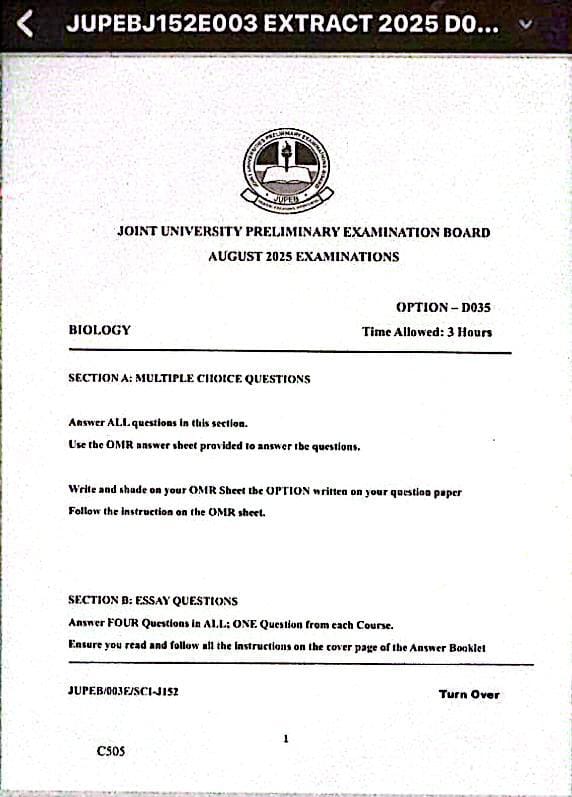JUPEB Biology Theory And Objective Questions And Answers 2025
JUPEB BIOLOGY THEORY QUESTIONS (BIO 001 – BIO 004)
MODULE BIO 001: Diversity of Organisms
1 (a) Outline the five kingdoms of living organisms and list one distinguishing feature of each.
(b) Discuss the economic importance of bacteria and fungi.
2 (a) List four characteristics used in classifying plants.
(b) Compare the reproductive features of Bryophyta and Pteridophyta.
3 With labeled diagrams, describe the external features of:
(a) an insect
(b) a bony fish
4 Write short notes on:
- Viruses as living and non-living organisms
- Parasitic protozoa
- Economic importance of algae
MODULE BIO 002: Form and Functions in Plants and Animals
5 (a) Describe the structure and function of the xylem and phloem.
(b) Compare transport in plants and animals.
6 (a) Define photosynthesis.
(b) Describe an experiment to demonstrate the necessity of light in photosynthesis.
(c) Write the balanced chemical equation of photosynthesis.
7 (a) Discuss the process of digestion in humans.
(b) What are enzymes? List four enzymes and their functions in the digestive system.
8 (a) Draw and label the human heart.
(b) Explain the double circulation of blood in humans.
9 (a) Describe how plants absorb and transport water.
(b) List three factors affecting transpiration.
MODULE BIO 003: Ecology and Evolution
10 (a) Define the following:
(i) Ecosystem
(ii) Food chain
(iii) Trophic level
(b) Construct a food chain showing five organisms and identify the producers and consumers.
11 (a) What is pollution?
(b) Mention four types of pollution and their sources.
(c) Suggest two ways of controlling pollution.
12 (a) State the major biotic and abiotic components of an ecosystem.
(b) Describe how energy flows through an ecosystem.
14 (a) What is natural selection?
(b) State two evidences supporting organic evolution.
MODULE BIO 004: Cell Biology, Genetics, Reproduction & Growth
14 (a) Draw and label the animal and plant cell.
(b) Mention two differences between plant and animal cells.
15 (a) What are chromosomes?
(b) Define the following genetic terms:
(i) Allele
(ii) Genotype
(iii) Phenotype
(iv) Homozygous
(v) Heterozygous
16 Use the law of segregation to solve the following problem:
“In garden peas, tall (T) is dominant to short (t). Cross two heterozygous tall plants and determine the genotypic and phenotypic ratio of the offspring.”
17 (a) Differentiate between asexual and sexual reproduction.
(b) Describe the structure and function of the male reproductive system in humans.
18 (a) Define mitosis and meiosis.
(b) State two differences between them.
(c) Mention the significance of meiosis in reproduction.

JUPEB Biology Theory Answers 2025
(1a)
(i) Kingdom Monera – Prokaryotic cell structure: Organisms in this kingdom are unicellular and prokaryotic, meaning they do not have a true nucleus or membrane-bound organelles. Their genetic material is found freely in the cytoplasm. They reproduce asexually, often through binary fission. Some are autotrophic (such as cyanobacteria that perform photosynthesis), while others are heterotrophic. Examples include bacteria and blue-green algae.
(ii) Kingdom Protista – Unicellular eukaryotes: Protists are primarily unicellular organisms but are eukaryotic, meaning they possess a true nucleus and other membrane-bound organelles. They show both plant-like (algae) and animal-like (protozoa) features. Protists live mostly in aquatic environments and exhibit various modes of nutrition, including photosynthesis, ingestion, and absorption. Examples include Amoeba, Paramecium, and Euglena.
(iii) Kingdom Fungi – Absorptive heterotrophy: Fungi are mostly multicellular (except for yeasts) and are eukaryotic. They obtain nutrients through absorption by secreting digestive enzymes into their surroundings and absorbing the broken-down organic matter. Their cell walls are made of chitin (unlike plants, which have cellulose). They play a major role in decomposition and nutrient cycling. Examples include mushrooms, molds, and yeasts.
(iv) Kingdom Plantae – Autotrophic nutrition through photosynthesis: Members of this kingdom are multicellular, eukaryotic, and autotrophic, meaning they produce their own food using sunlight, carbon dioxide, and water through the process of photosynthesis. Their cells have chloroplasts containing chlorophyll and are enclosed by rigid cell walls made of cellulose. Plants form the base of most food chains. Examples include trees, grasses, mosses, and flowering plants.
(v) Kingdom Animalia – Ingestive heterotrophy and complex body systems: Animals are multicellular, eukaryotic organisms that rely on consuming other organisms for food (heterotrophs). They have highly specialized cells and tissues forming complex organ systems. Unlike plants and fungi, they do not have cell walls. Most animals are capable of locomotion and reproduce sexually. Examples include humans, insects, birds, and fish.
(1b)
=ECONOMIC IMPORTANCE OF BACTERIA=
(i) Agriculture (Nitrogen Fixation and Soil Fertility): Certain bacteria such as Rhizobium live symbiotically in the root nodules of leguminous plants and fix atmospheric nitrogen into forms that plants can absorb, like nitrates. This natural process enhances soil fertility and reduces the need for chemical fertilizers. Other free-living nitrogen-fixing bacteria like Azotobacter and Clostridium also contribute to soil nutrient enrichment.
(ii) Food Industry (Fermentation and Preservation): Bacteria play a major role in the production of fermented foods. Lactobacillus is used to produce yogurt, cheese, curd, and sour cream by converting lactose into lactic acid. Acetobacter is used in vinegar production by converting alcohol into acetic acid. These processes improve flavor, shelf-life, and digestibility of food products.
(iii) Medicine and Pharmaceutical Industry: Some bacteria are valuable for producing antibiotics that are used to treat bacterial infections. For example, Streptomyces produces antibiotics like streptomycin, chloramphenicol, and tetracycline. Additionally, genetically engineered bacteria like Escherichia coli are used to manufacture important human hormones such as insulin and growth hormone.
(iv) Environmental Management (Waste Decomposition and Bioremediation): Decomposer bacteria help break down organic waste in sewage treatment and composting systems. Certain bacteria are also used in bioremediation, a process where bacteria are employed to clean up pollutants such as oil spills, heavy metals, and toxic waste from the environment, helping restore ecological balance.
(v) Industrial Biotechnology: Bacteria are used to produce enzymes, vitamins (like B12), amino acids, biofuels, and biodegradable plastics. For example, Bacillus subtilis is used in the production of protease and amylase enzymes, which are applied in detergents, textile processing, and leather industries.
=ECONOMIC IMPORTANCE OF FUNGI=
(i) Food and Beverage Production: Fungi such as Saccharomyces cerevisiae (baker’s yeast) are essential in baking, brewing, and winemaking. In baking, the yeast ferments sugars in the dough to release carbon dioxide, which makes bread rise. In brewing and wine production, yeast converts sugars into alcohol and carbon dioxide through fermentation, forming the basis of alcoholic beverage industries.
(ii) Pharmaceutical Industry (Antibiotics and Drugs): Fungi have greatly contributed to medicine. Penicillium notatum produces penicillin, the first antibiotic discovered, which revolutionized the treatment of bacterial infections. Other fungi are sources of drugs such as cyclosporin (used in organ transplantation to suppress immune rejection) and statins (used to lower cholesterol levels).
(iii) Agriculture (Biocontrol and Soil Health): Fungi such as Trichoderma are used as biocontrol agents against plant pathogens, reducing the need for chemical fungicides and pesticides. Mycorrhizal fungi form symbiotic relationships with plant roots, improving nutrient and water absorption, thereby enhancing crop yield and soil structure.
(iv) Decomposition and Recycling of Nutrients: Fungi play a key role in breaking down complex organic matter like dead plants and animals. This decomposition process recycles nutrients back into the soil, maintaining ecological balance and supporting plant growth in natural and agricultural ecosystems.
(v) Industrial Production of Chemicals and Enzymes: Fungi are used in producing commercially valuable products such as citric acid (from Aspergillus niger), which is used in food and beverages, detergents, and pharmaceuticals. Fungal enzymes like cellulase and pectinase are used in paper, textile, and juice industries to enhance product quality and processing efficiency.
=========
(13a)
Natural selection is the process by which organisms with traits that are better suited to their environment are more likely to survive, reproduce, and pass on those traits to their offspring. Over time, this leads to the evolution of species as advantageous traits become more common in a population.
(13b)
(PICK ANY TWO)
(i) Fossil records: Fossils show changes in organisms over long periods of time, indicating gradual evolution.
(ii) Comparative anatomy: Similar structures (like bones in the limbs of humans, bats, and whales) suggest a common ancestry.
(iii) Embryology: Early stages of embryos of different species (e.g., fish, birds, humans) show similar features, indicating common origins.
(iv) Biogeography: The geographic distribution of organisms supports the idea that species evolved differently in different environments.
(v) Molecular biology: Similar DNA and protein structures across species show genetic relationships and common ancestry.
(vi) Vestigial structures: Body parts that have lost their original function (e.g., human appendix, hind limbs in whales) suggest evolution from ancestors who used them.
=========
*JUPEB BIOLOGY ANSWERS*
*NUMBER FIFTEEN*
(15a)
Chromosomes are thread-like structures found in the nucleus of cells that carry genetic information in the form of DNA (deoxyribonucleic acid). Each chromosome contains many genes, which are units of heredity passed from parents to offspring. In humans, chromosomes come in pairs, 23 pairs (46 chromosomes in total).
(15b)
(i) Gene: A gene is a segment of DNA that controls a specific trait or function by coding for a particular protein. It is the basic unit of heredity.
(ii) Allele: An allele is a different version of the same gene. Alleles can be dominant or recessive and are responsible for variations in inherited characteristics.
(iii) Genotype: This refers to the genetic makeup of an organism, the combination of alleles an organism carries (e.g., TT, Tt, or tt).
(iv) Phenotype: This is the physical or observable trait or characteristic of an organism resulting from the interaction of its genotype with the environment (e.g., tall or short plant).
(v) Homozygous: An organism is said to be homozygous when it has two identical alleles for a particular gene (e.g., TT or tt).
(vi) Heterozygous: An organism is heterozygous when it has two different alleles for a particular gene (e.g., Tt).
ALSO READ; JUPEB Biology Practical Specimens 2025 and Likely Questions with Answers

Mr. Femi is an education blogger who simplifies exam updates and study tips for Nigerian students. His goal is to make learning smart, easy, and rewarding.
